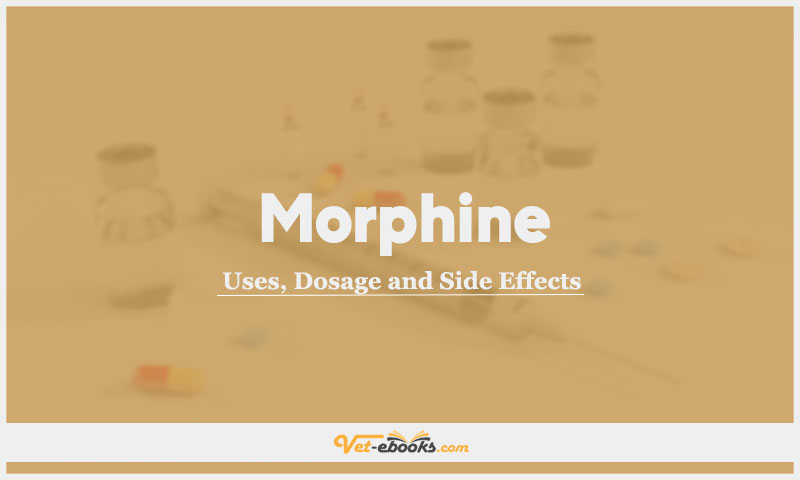Morphine In Dogs & Cats: Uses, Dosage and Side Effects

Overview
- Analgesia is mediated by the mu-opioid receptor.
Uses of Morphine
- Management of moderate to severe pain in the perioperative period.
- Morphine can be given as a constant rate infusion to provide analgesia intraoperatively and in the postoperative period.
- Incorporation into sedative and pre-anaesthetic medication protocols to provide improved sedation and analgesia.
- Preservative-free morphine can be administered into the epidural space where it will provide analgesia for up to 24 hours.
Dose of Morphine in Dogs and Cats
Dogs:
Analgesia:
- a dose of 0.5 mg/kg i.v., i.m. q2h is required to produce analgesia in experimental models.
- Pain should be assessed frequently and the dose adjusted based on the requirement for analgesia.
- Continuous rate infusion: 0.15–0.2 mg/kg/h i.v.
Epidural morphine (use Duramorph as it is preservative-free):
- 0.1–0.2 mg/kg diluted with 0.26 ml/kg of sterile saline (up to a total maximum volume of 6 ml in all dogs).
- There is a latent period of 30–60 minutes following epidural administration;
duration of action is 18–24 hours.
Cats:
Analgesia:
- 0.1–0.4 mg/kg i.v., i.m. q3–4h.
- Pain should be assessed frequently and the dose adjusted based on the requirement for analgesia.
- Continuous rate infusions of morphine have not been widely evaluated in cats.
Epidural morphine:
- dose as for dogs.
Drug Dosage Calculator
You Should Give:
Side Effects of Morphine in Dogs and Cats
- Morphine can cause respiratory depression, although this is unlikely when used
at clinical doses in awake cats and dogs. - Respiratory depression may occur when given i.v. during general anaesthesia due to increased depth of anaesthesia.
- Vomiting is common after morphine administration and it causes constriction of GI sphincters (such as the pyloric sphincter) and may cause a reduction in GI motility when given over a long period.
- Morphine crosses the placenta and may exert sedative effects in neonates born to bitches treated prior to parturition.
- Severe adverse effects can be treated with naloxone.
Contraindications of Morphine in Dogs and Cats
- No information is available.
Some Notes:
- Other CNS depressants (e.g. anaesthetics, antihistamines, barbiturates, phenothiazines, tranquillizers) may cause increased CNS or respiratory depression when used
concurrently with narcotic analgesics. - The utilisation of methadone is recommended above morphine as the authorised substitute for administering single or repeated bolus doses to canines and felines.
- The increased accessibility of data pertaining to the pharmacological properties and administration of morphine via continuous rate infusion may provide a rationale for prioritising its utilisation above methadone in this particular mode of drug delivery.
- Morphine serves as the benchmark opioid against which all other opioids are measured.
- It offers significant pain relief and is a fundamental component of analgesic treatments following surgical procedures in human patients.
- In canines, the medication has a brief period of efficacy and necessitates repeated administration in order to achieve desired outcomes.
- Constant rate infusions (CRIs) can also be employed as a means to address this particular constraint.
- The length of action in felines has not been thoroughly assessed; nonetheless, it seems to have a duration of action ranging from 3 to 4 hours.
- Accumulation is a probable outcome following the administration of repeated doses over an extended period of time. This phenomenon may enable a reduction in dosage or an extension of the dosing interval. When administered intravenously at a rapid rate, morphine induces the release of histamine.
- It is recommended to dilute the drug and administer it intravenously at a gradual rate.
- Administering morphine to animals prior to surgery who are not experiencing pain often leads to vomiting.
- It is advisable to avoid using morphine in cases where vomiting is prohibited, such as in animals with elevated intraocular pressure.
- Transient excitation can potentially manifest when intravenous administration of morphine is administered.
- The utilisation of oral morphine in feline and canine patients is infrequent due to its high first-pass metabolism, resulting in a diminished plasma concentration after to oral administration.
- It is imperative to monitor respiratory function in anaesthetized patients who are administered morphine.
- The response to opioids exhibits variability across individual patients, thereby necessitating the assessment of pain following their delivery.
- The metabolism of morphine takes place in the liver, and those with poor liver function may experience a lengthened duration of its effects.
Tip
Do You Want To Increase Your Veterinary Knowledge and Practical Skills?
You Can Now Browse and Download +3000 Books For Veterinary Professionals & Students Online.
Download Veterinary Books




















